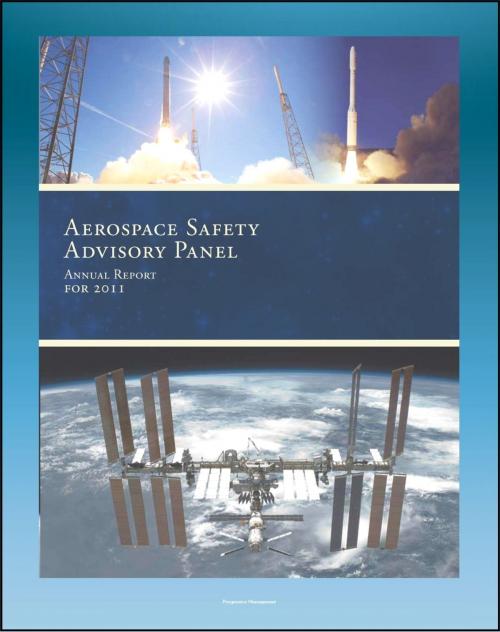2011 NASA Aerospace Safety Advisory Panel (ASAP) Annual Report, Issued January 2012 - Space Shuttle, International Space Station, Commercial Crew and Cargo, SpaceX, Human Rating, Exploration Program
Nonfiction, Science & Nature, Science, Physics, Cosmology, Astrophysics & Space Science| Author: | Progressive Management | ISBN: | 9781465934994 |
| Publisher: | Progressive Management | Publication: | March 8, 2012 |
| Imprint: | Smashwords Edition | Language: | English |
| Author: | Progressive Management |
| ISBN: | 9781465934994 |
| Publisher: | Progressive Management |
| Publication: | March 8, 2012 |
| Imprint: | Smashwords Edition |
| Language: | English |
The 2011 report by the ASAP safety advisory panel to NASA, released in January 2012, presents findings on the space station, shuttle program completion, noteworthy launches, Soyuz return to earth, commercial crew, Space Launch System (SLS) and Multi-Purpose Crew Vehicle (MPCV), how safe is safe enough, preparing for future low-probability events, knowledge management, transparency, alcohol usage and the 2006 fall fatality, and much more. In addition to the full 2011 report, the revealing minutes of ASAP public meetings in 2011 and early 2012, and the 2010 ASAP report, are also included in this flowing-text ebook format reproduction.
From Chairman Dyer's introduction letter: This report is based on the Panel's 2011 fact-finding and quarterly public meetings; "insight" visits and meetings; direct observations of NASA operations and decision-making; discussions with NASA management, employees, and contractors; and the Panel members' past experiences. In our report we highlight issues on cost, schedule, resources, requirements and acquisition strategy that impact safety. Further, we again note the uncertainty regarding goals and objectives and the need for clarity and constancy of purpose. Importantly, we also acknowledge several of NASA's many accomplishments during calendar year 2011. We observe that transparency, the evolution of a safe and open culture, and key process advances have all significantly improved under your leadership.
A key and honest question that we pose is: "How safe is safe enough?" The pursuit of great reward often comes hand in hand with great risk—so it has always been with explorers. The answer to the question must come from a balance between risk and reward and should reflect a consensus among the American people, the White House, the Congress, and NASA. It is not our intent or purpose to answer the question; however, we point to areas where we believe the stated requirement may not produce the requisite safety. We especially invite your attention to the section "Reassessment of Space Shuttle Risks" and the historical gap between anticipated and deployed systems risk.
In this report, we have assumed that the purpose of the commercial crew initiative is to facilitate the near-term development of a U.S. commercial space transportation capability to achieve safe, reliable, and cost-effective access to and from low-Earth orbit (LEO). However, some among the stakeholders believe human transport to LEO is not the primary intent of the commercial crew initiative. They believe the intent is, instead, to foster a domestic U.S. space industry over a longer time horizon. We note that attention to and investment in safety are critical in developing near-term transport to LEO but may not be as significant in seeding a future industry. Some of the funding decisions and the resultant shifts in acquisition strategy give credence to those who believe the objective has indeed changed. We believe clarity is needed, and constancy of purpose must follow in either regard. We strongly believe those setting national strategy, providing resources, and planning for execution must all share in acknowledging and shouldering the risk. To speak more plainly, if NASA attempts to execute an underfunded program to an unrealistic schedule, the accountability for accepting the associated risk must be shared.
The 2011 report by the ASAP safety advisory panel to NASA, released in January 2012, presents findings on the space station, shuttle program completion, noteworthy launches, Soyuz return to earth, commercial crew, Space Launch System (SLS) and Multi-Purpose Crew Vehicle (MPCV), how safe is safe enough, preparing for future low-probability events, knowledge management, transparency, alcohol usage and the 2006 fall fatality, and much more. In addition to the full 2011 report, the revealing minutes of ASAP public meetings in 2011 and early 2012, and the 2010 ASAP report, are also included in this flowing-text ebook format reproduction.
From Chairman Dyer's introduction letter: This report is based on the Panel's 2011 fact-finding and quarterly public meetings; "insight" visits and meetings; direct observations of NASA operations and decision-making; discussions with NASA management, employees, and contractors; and the Panel members' past experiences. In our report we highlight issues on cost, schedule, resources, requirements and acquisition strategy that impact safety. Further, we again note the uncertainty regarding goals and objectives and the need for clarity and constancy of purpose. Importantly, we also acknowledge several of NASA's many accomplishments during calendar year 2011. We observe that transparency, the evolution of a safe and open culture, and key process advances have all significantly improved under your leadership.
A key and honest question that we pose is: "How safe is safe enough?" The pursuit of great reward often comes hand in hand with great risk—so it has always been with explorers. The answer to the question must come from a balance between risk and reward and should reflect a consensus among the American people, the White House, the Congress, and NASA. It is not our intent or purpose to answer the question; however, we point to areas where we believe the stated requirement may not produce the requisite safety. We especially invite your attention to the section "Reassessment of Space Shuttle Risks" and the historical gap between anticipated and deployed systems risk.
In this report, we have assumed that the purpose of the commercial crew initiative is to facilitate the near-term development of a U.S. commercial space transportation capability to achieve safe, reliable, and cost-effective access to and from low-Earth orbit (LEO). However, some among the stakeholders believe human transport to LEO is not the primary intent of the commercial crew initiative. They believe the intent is, instead, to foster a domestic U.S. space industry over a longer time horizon. We note that attention to and investment in safety are critical in developing near-term transport to LEO but may not be as significant in seeding a future industry. Some of the funding decisions and the resultant shifts in acquisition strategy give credence to those who believe the objective has indeed changed. We believe clarity is needed, and constancy of purpose must follow in either regard. We strongly believe those setting national strategy, providing resources, and planning for execution must all share in acknowledging and shouldering the risk. To speak more plainly, if NASA attempts to execute an underfunded program to an unrealistic schedule, the accountability for accepting the associated risk must be shared.















